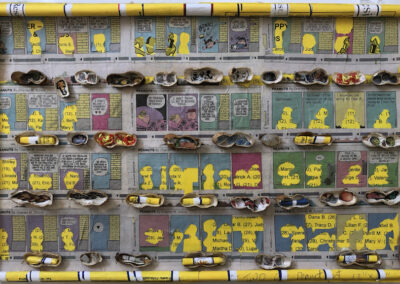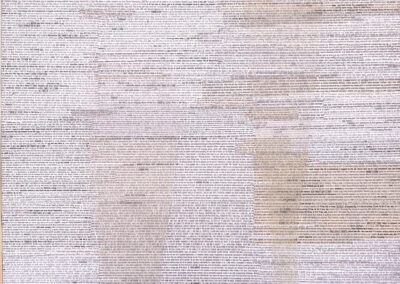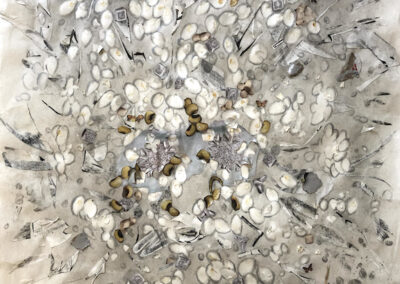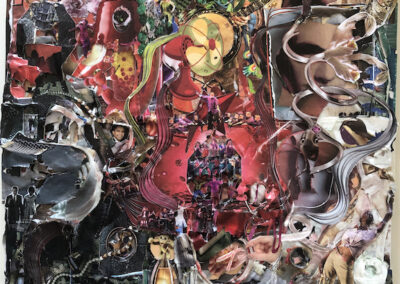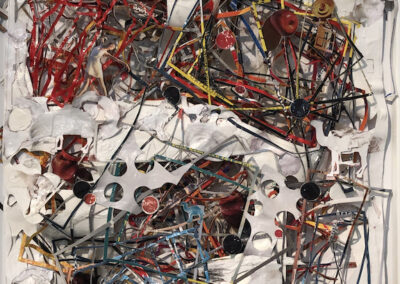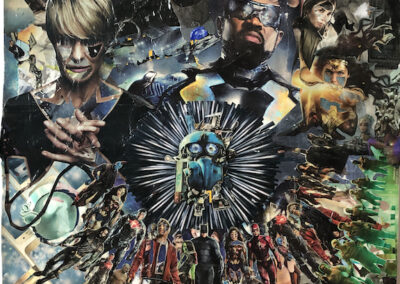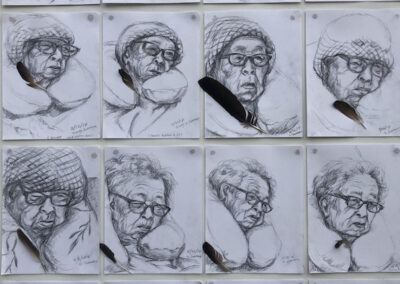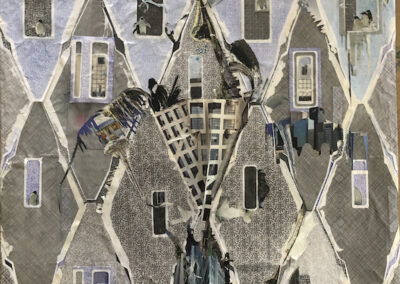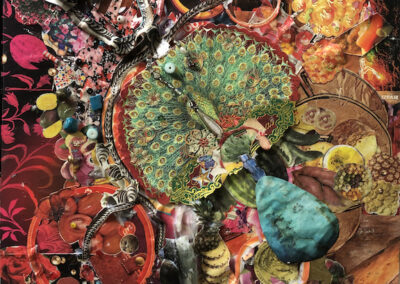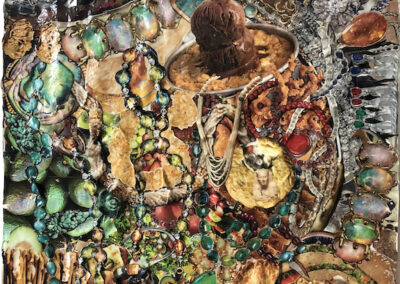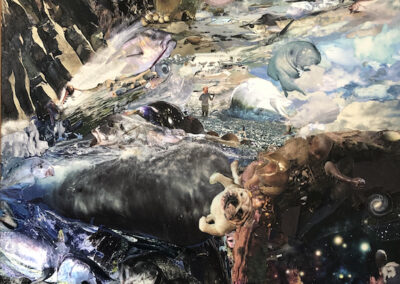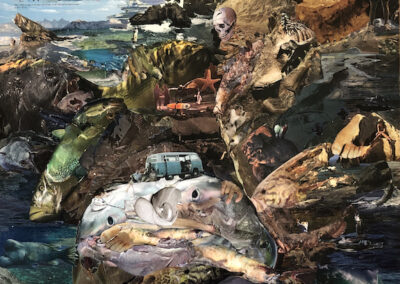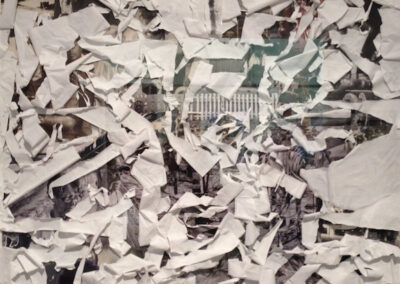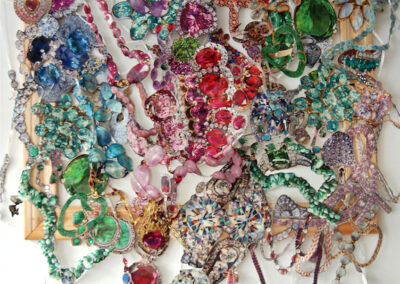Finding Me III – Artwork by Young Summers. Music by Kevin Goode
Click to read ESSAY by DOUG HARVEY
SUMMERS OF OUR DISCONTENT: Young Summers’ Collage Work
When I first encountered Young Summer’s work, it consisted primarily of quite accomplished figurative portraiture and landscape painting. Summers — a mature artist who was then escaping a creatively unrewarding career in advertising layout – embarked on a trajectory that folded the physical cut & paste technologies of pre-digital graphic design into her strongly developed aesthetic vocabulary, then exploded it from within, resulting in the rapid stylistic evolution visible in the gallery survey Finding Me III.
While Summers work has continued to include painting and drawing, it also encompasses experimental printmaking, multimedia, and relational aesthetics. But her most substantial oeuvre, and the focus of this show, has been her collages. As a lifelong collage artist myself (among other things) I may be biased, but my understanding of art history places collage at the fulcrum of Modernism, both in the “actual-oilcloth-in-the-cubist-still-life” sense and the “human consciousness has now disintegrated into a constantly shifting mosaic of infinitely mutable fragments” sense. Summers’ last decade of cut paper assemblages comprise an object lesson in both senses.
She began her deconstructive arc with a splash, translating her well-structured academic seascapes into an astounding series of meticulously compiled “Beach Rocks” collages. These large-scale works carefully rendered three-dimensional forms and space – often possessing a vertiginous Northern Renaissance clarity – using the inherent illusionistic depth of her source images, but also their strictly formal color, tonal, and textural qualities, sometimes even operating at odds with the pictorial content of the original image.
The relationship between the source materials and the collage image is complex. Cloud and water photos are cut apart and reassembled to depict cloud and water. In the same landscape, however, rock formations may be made from sea creatures or human skulls and tidepools out of galaxies. Closer inspection reveals tiny incursions of fragmentary architectural details, musical instruments, machinery, and most frequently human figures that often warp the initial perspectival illusion, opening portals into incongruous dimensions.
Summers’ subsequent series have pretty much abandoned reliance on a mimetic master image while retaining the symbolic play and exploring the tension between spatial illusion and the flatness of the picture plane. The pictorial sources themselves have evolved towards glut-tacular consumer objects, perhaps partly in recognition of the nature-as-commodity subtext already lurking beneath the surface of the Beach Rocks series (Sous la plage, le marché!”)
But more to the point is Summer’s increasingly critical attitude towards wasteful materialism, and her attempt to calibrate her artistic process into a literal and metaphorically oppositional operational stance. Her visually dazzling gem series, her clotted fields of grocery flier food images, her various other maps of home shopping purgatory – each is an attempt to short circuit the desire-inducing mechanisms of the visual language of advertising by intensifying the attention paid to the ostensibly disposable desire triggers and transforming them into saturated distillations more exquisite than the potential possessions or experiences they index.
At the same time, these works testify to the astronomical abundance of these symbolic desire triggers in contemporary visual culture, the horror vacuii bombardment of the average citizen’s attention with tantalizing icons and avatars, and the resultant devaluation of attention, desire, and the objects of desire. Moreover, these works bear witness to the cavalier waste of real physical resources entailed in the production and distribution of junk mail and advertising-
driven print media.
This last function is also at play in Summers’ collages that focus on repurposing unsolicited junk mail of a less visually seductive appearance; her elegant abstract arrangements of security envelope lining patterns and illegible blocks of fine-print disclaimers. These works, drained of color, offer a more elegiac version of Summers’ critique of Consumer Society, emphasizing the hidden costs, terms, and conditions, and exposing its Janus-face as the Surveillance State.
The works are elegiac in another sense, as Summers lost her mother, husband, and most tragically, her son (a gifted young pianist with an undiagnosed heart condition) in rapid succession during this period. Her grid of intimate portrait drawings of her mother undergoing dialysis are countered and augmented by later collages that forego the meticulous image-based works for fields of visual information torn asunder by the irrationality and unpredictability of life, the creative life.
Perhaps what’s most remarkable in Summers’ later work is the retention, even amplification, of her playful humor. I’ve made these artifacts sound grim and even self-righteous, but they’re quite the opposite. In a master stroke of logical absurdism that seems inevitable in retrospect, Summers extends her critique of consumerism to herself and her own behavior – putting her money where her mouth is by turning her repurposing vengeance on the detritus of her own existence – the leftover trimmings of her collage process, return address labels, the dried scabs of paint from her old palettes, the shells of consumed peanuts, the sheets of charcoal-on-newsprint imagery from figure drawing sessions, and so on.
Never less than visually arresting, life-affirming and experimentally adventurous, the collage work of Young Summers’ has, over the course of a decade, recapitulated the formal Modernist progressions that dismantled the authoritarian academicism of the 19th century (and preceding 500 years), then brought it to a point of personal and political immediacy that can’t fail to resonate with any artist confronting the dilemmas of contemporary culture, even pointing towards a possible way out. I guess we’ll just have to wait for Finding Me IV.
— Doug Harvey
https://dougharvey.blogspot.com
GALLERY OF RECENT ARTWORKS
Men, Charcoal pencil and sumi ink drawings collaged on civil engineers’ drafting paper, cut papers on paper, 30” x 43”, 2021/2022
Seeds of Ideas, mixed media on printmaking paper, spray printed with recycled sumi ink water, charcoal pencil, found images and seeds, 23 1/2” x 30”, 2018/2020



